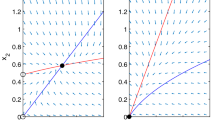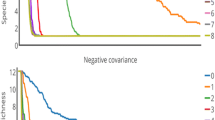Abstract
In order to clarify the theoretical relationship between individual behavior and population-level competition between two species with spatial correlation, this paper describes how discrete-time competition equations for the two species can be derived from local resource competition among individuals. Competition type of each species is either scramble, contest, or modified contest, and for various combinations of two competition types, different competition models are derived. Simple competition models that can approximate the above models when competition is weak are also derived. Furthermore, the derived models are used to investigate how coexistence conditions and coexistence probability depend on spatial correlation and aggregation of individuals. For the weak competition models, spatial aggregation and non-correlation, in terms of measures adopted here, play exactly symmetric roles in promoting coexistence. In contrast, for the fully developed models, spatial aggregation generally exerts stronger effects than non-correlation on coexistence. Coexistence probability also depends greatly on competition types. For example, two species are generally more likely to coexist when they are of the same competition type than of different competition types. Coexistence probabilities from the mathematical analysis are in good agreement with those from individual-based simulations.





Similar content being viewed by others
References
Anazawa M (2009) Bottom-up derivation of discrete-time population models with the Allee effect. Theor Popul Biol 75:56–67
Anazawa M (2010) The mechanistic basis of discrete-time population models: The role of resource partitioning and spatial aggregation. Theor Popul Biol 77:213–218
Anazawa M (2012a) Bottom-up derivation of population models for competition involving multiple resources. Theor Popul Biol 81:158–167
Anazawa M (2012b) Interspecific competition models derived from competition among individuals. Bulletin Math Biol 74:1580–1605
Anderson RM, May R M (1978) Regulation and stability of host-parasite population interactions: I. regulatory processes. J Anim Ecol 219–247
Atkinson WD, Shorrocks B (1981) Competition on a divided and ephemeral resource: a simulation model. J Anim Ecol 461–471
Atkinson WD, Shorrocks B (1984) Aggregation of larval diptera over discrete and ephemeral breeding sites: the implications for coexistence. Amer Nat 336–351
Bliss CI, Fisher RA (1953) Fitting the negative binomial distribution to biological data. Biometrics 9:176–200
Boswell MT, Patil GP (1970) Chance mechanisms generating the negative binomial distributions. In: Patil GP (ed) Random counts in scientific work, vol 1. Pennsylvania State University Press, University Park, pp 3–22
Brännström Å, Dieckmann U (2005) Evolutionary dynamics of altruism and cheating among social amoebas. Proc R Soc B 272:1609–1616
Brännström Å, Gross T, Blasius B, Dieckmann U (2011) Consequences of fluctuating group size for the evolution of cooperation. J Math Biol 63:263–281
Brännström Å, Sumpter DJT (2005a) Coupled map lattice approximations for spatially explicit individual-based models of ecology. Bulletin Math Biol 67:663–682
Brännström Å, Sumpter DJT (2005b) The role of competition and clustering in population dynamics. Proc R Soc B 272:2065–2072
Brännström Å, Sumpter DJT (2006) Stochastic analogues of deterministic single-species population models. Theor Popul Biol 69:442–451
Chesson P (1998a) Making sense of spatial models in ecology. In: Bascompte J, Sole RV (Eds.), Modeling spatiotemporal dynamics in ecology. Springer, pp. 151–166
Chesson P (1998b) Spatial scales in the study of reef fishes: a theoretical perspective. Aust J Ecol 23:209–215
Chesson P (2012) Scale transition theory: its aims, motivations and predictions. Ecolog Complex 10:52–68
Chesson P, Donahue MJ, Melbourne BA, Sears ALW (2005) Scale transition theory for understanding mechanisms in metacommunities. In: Holyoak M, Leibold MA, Holt RD (eds) Metacommunities: spatial dynamics and ecological communities. The University of Chicago Press, Chicago, pp 279–306
De Jong G (1978) The influence of the distribution of juveniles over patches of food on the dynamics of a population. Neth J Zool 29:33–51
Eskola HTM, Geritz SAH (2007) On the mechanistic derivation of various discrete-time population models. Bulletin Math Biol 69:329–346
Eskola HTM, Parvinen K (2007) On the mechanistic underpinning of discrete-time population models with Allee effect. Theor Popul Biol 72:41–51
Eskola HTM, Parvinen K (2010) The Allee effect in mechanistic models based on inter-individual interaction processes. Bulletin Math Biol 72:184–207
Fujii K (1965) A statistical model of the competition curve. Res Popul Ecol 7:118–125
Geritz SAH, Kisdi É (2004) On the mechanistic underpinning of discrete-time population models with complex dynamics. J Theor Biol 228:261–269
Gotzen B, Liebscher V, Walcher S (2011) On a class of deterministic population models with stochastic foundation. Bulletin Math Biol 73:1559–1582
Grimm V, Railsback SF (2005) Individual-based modeling and ecology. Princeton University Press, Princeton
Grimm V, Uchmański J (2002) Individual variability and population regulation: a model of the significance of within-generation density dependence. Oecologia 131:196–202
Hartley S, Shorrocks B (2002) A general framework for the aggregation model of coexistence. J Anim Ecol 71:651–662
Hassell MP (1975) Density-dependence in single-species populations. J Anim Ecol 44:283–295
Hassell MP, Comins HN (1976) Discrete time models for two-species competition. Theor Popul Biol 9:202–221
Hassell MP, May RM (1985) From individual behaviour to population dynamics. In: Sibley RM, Smith RM (Eds.), Behavioral ecology: ecological consequences of adaptive behaviour. Blackwell, pp. 3–32
Ives AR (1988a) Aggregation and the coexistence of competitors. Ann Zool Fenn 25:75–88
Ives AR (1988b) Covariance, coexistence and the population dynamics of two competitors using a patchy resource. J Theor Biol 133:345–361
Ives AR (1991) Aggregation and coexistence in a carrion fly community. Ecol Monogr 61(1):75–94
Ives AR, May RM (1985) Competition within and between species in a patchy environment: relations between microscopic and macroscopic models. J Theor Biol 115:65–92
Johansson A, Sumpter DJT (2003) From local interactions to population dynamics in site-based models of ecology. Theor Popul Biol 64:497–517
Johst K, Berryman A, Lima M (2008) From individual interactions to population dynamics: individual resource partitioning simulation exposes the cause of nonlinear intra-specific competition. Popul Ecol 50:79–90
Johst K, Lima M, Berryman AA (2013) Scaling up: how do exogenous fluctuations in individual-based resource competition models re-emerge in aggregated stochastic population models? Popul Ecol 55(1):173–182
Kisdi É, Utz M (2005) Does quasi-local competition lead to pattern formation in metapopulations? an explicit resource competition model. Theor Popul Biol 68:133–145
Kotz S, Balakrishnan N, Johnson NL (2000) Continuous multivariate distributions, models and applications, vol. 1. Wiley
Łomnicki A (1988) Population ecology of individuals. Princeton University Press, Princeton
Łomnicki A (2009) Scramble and contest competition, unequal resource allocation, and resource monopolization as determinants of population dynamics. Evol Ecol Res 11:371–380
Melbourne BA, Chesson P (2006) The scale transition: scaling up population dynamics with field data. Ecology 87:1478–1488
Nicholson AJ (1954) An outline of the dynamics of animal populations. Aust J Zool 2:9–65
Nonaka E, Parvinen K, Brännström Å (2013) Evolutionary suicide as a consequence of runaway selection for greater aggregation tendency. J Theor Biol 317:96–104
Rosewell J, Shorrocks B, Edwards K (1990) Competition on a divided and ephemeral resource: testing the assumptions. i. aggregation. J Anim Ecol 59(3):977–1001
Royama T (1992) Analytical population dynamics. Chapman & Hall, London
Sevenster JG (1996) Aggregation and coexistence. i. theory and analysis. J Anim Ecol 297–307
Shorrocks B, Atkinson W, Charlesworth P (1979) Competition on a divided and ephemeral resource. J Anim Ecol 899–908
Sumpter DJT, Broomhead DS (2001) Relating individual behaviour to population dynamics. Proc R Soc B 268:925–932
Sutherland WJ (1996) From individual behaviour to population ecology. Oxford University Press, Oxford
Takano M, Toquenaga Y, Fujii K (2001) Polymorphism of competition type and its genetics in callosobruchus maculatus (coleoptera: Bruchidae). Popul Ecol 43:265–273
Thanthianga C, Mitchell R (1987) Vibrations mediate prudent resource exploitation by competing larvae of the bruchid bean weevil callosobruchus maculatus. Entomol Exp Appl 44:15–21
Toquenaga Y (1993) Contest and scramble competitions in callosobruchus maculatus (coleoptera: Bruchidae) ii. larval competition and interference mechanisms. Res Popul Ecol 35:57–68
Uchmański J (2000) Resource partitioning among competing individuals and population persistence: an individual-based model. Ecol Model 131:21–32
Varley GC, Gradwell GR, Hassell MP (1974) Insect population ecology: an analytical approach. University of California Press, Oakland
Acknowledgments
I am grateful to Kazunori Sato, Hideo Ezoe, and Fugo Takasu for useful comments and discussions. I also thank two anonymous reviewers for their careful readings and helpful comments which have greatly improved the manuscript.
Author information
Authors and Affiliations
Corresponding author
Electronic supplementary material
Below is the link to the electronic supplementary material.
Appendices
Appendix 1
This appendix provides a derivation of the probability generating function (4) of individual distribution. Let \(M(t_1, t_2)\) be the moment generating function (mgf) of the accessibilities \(a_1\) and \(a_2\), defined in terms of the joint probability density \(p_A(a_1, a_2)\) as
Then, the mgf of Kibble–Moran’s bivariate gamma distribution with mean 1 is given by (Kotz et al. 2000)
where \(\lambda \,(>0)\) is a shape parameter proportional to the variance, and \(\rho \,(0\le \rho \le 1)\) is the correlation coefficient between \(a_1\) and \(a_2\).
Letting \(p_i(\ell _i|a_i)\) be the conditional probability of finding exactly \(\ell _i\) individuals of species \(i\) in a given site with accessibility \(a_i\), we can write the joint distribution \(p(\ell _1,\ell _2)\) as
When we assume that each adult of species \(i\) lays eggs at a given site with a probability proportional to the site’s accessibility \(a_i\), and that the number of sites is infinitely large, the above conditional probabilities are Poisson distributed with mean \(a_1 x_t\) or \(a_2 y_t\):
Substituting Eqs. (42) into (41), and then substituting the result into the definition of the pgf \(G(z_1, z_2)\) of the distribution of individuals, Eq. (3), we have

Interchanging the orders of the summation and the integral, and then performing the summation gives

With Eq. (39), this equation can be written as \(M((z_1-1)x_t, (z_2-1)y_t)\), giving

which is Eq. (4).
Appendix 2
With the interaction functions derived in Electronic supplementary material for scramble competition, Eq. (1) is written as
where \(c_i=e^{-s_i/\bar{R}_i}\), and \(\hat{c}_{21}=e^{-\hat{s}_{21}/\bar{R}}\). Comparing these equations with the definition of \(G(z_1, z_2)\), Eq. (3), we observe that they can be written as
Then, substituting Eq. (4) for \(G(z_1, z_2)\) in the above equations finally gives Eq. (9) in Table 1.
Appendix 3
This appendix describes the derivation of Eq. (24). First, the pgf of the distribution of individuals \(G(z_1,z_2)\) defined by Eq. (3) is approximated by its second-order Taylor series around \(z_1=z_2=1\):
where \(*\) denotes that the functions are evaluated at \(z_1=z_2=1\). Next, from the definition of \(G(z_1, z_2)\) in Eq. (3), the derivatives of \(G(z_1, z_2)\) above can be written as
from which Eq. (48) can be written as
Finally, using this approximation instead of Eq. (4) in deriving competition models gives the following approximate model:
where \(\Gamma _{ij}\) for each competition case is defined in Sect. 3.2.
Appendix 4
This appendix presents some functions needed to evaluate the coexistence probability \(p_c\) for the contest vs. contest competition with the uniform distributions of competitive ability \(q_i(u)\) described in Fig. 2. First, the competition model described by Eq. (11) with
can be written as
where \(Q_i(Q_j)\) denotes \(Q_i(u)\) as a function of \(Q_j(u)\), given by
When \(x_t=0\) or \(y_t=0\), the integrals in Eq. (53) can be evaluated easily. When we express the growth rate of species \(i\) as \(g_i(x, y)=b_i G_i(x,y)\), the specific forms of \(G_2(0, y^*)\) and \(G_1(0, y^*)\), which are relevant to the invasibility of species 1, are given by
Similarly, the specific forms of \(G_1(x^*,0)\) and \(G_2(x*,0)\), which are relevant to the invasibility of species 2, are given by
Functions (55)–(58) are used to numerically evaluate the likelihood of two-species coexistence in Sect. 4.2.
Rights and permissions
About this article
Cite this article
Anazawa, M. Individual-Based Competition Between Species with Spatial Correlation and Aggregation. Bull Math Biol 76, 1866–1891 (2014). https://doi.org/10.1007/s11538-014-9980-4
Received:
Accepted:
Published:
Issue Date:
DOI: https://doi.org/10.1007/s11538-014-9980-4




